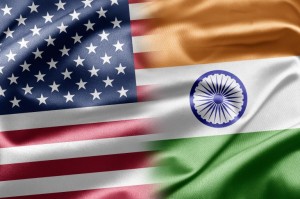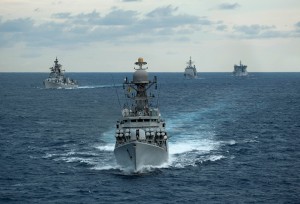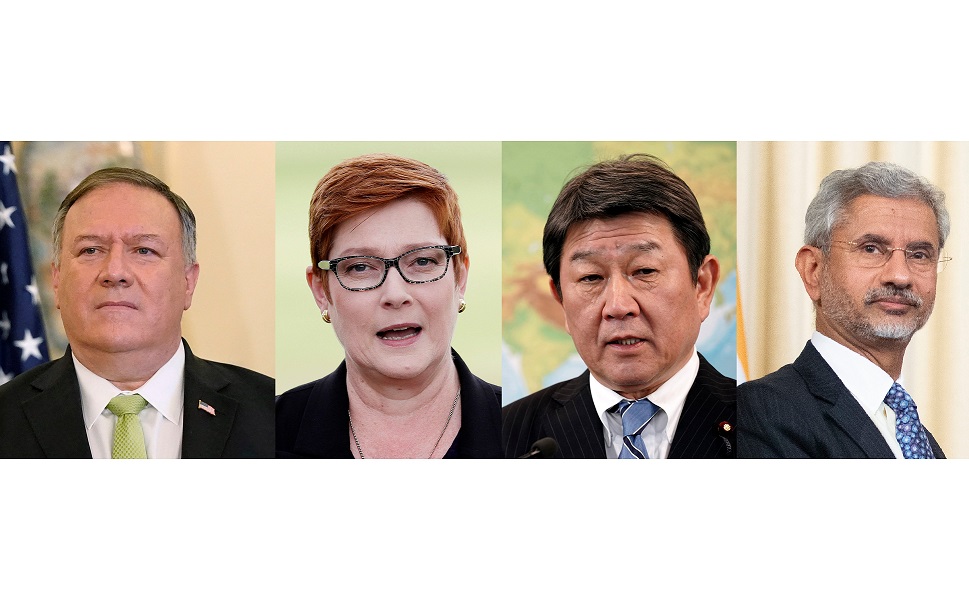Understanding The Indo-Pacific
The Indo-Pacific has become a locus of twenty-first century attention. It connects large swathes of the globe, which has made it a major geopolitical factor. The almost concurrent rise of China and India and the rapidly changing dynamics of the region now make this construct even more important. India’s increased regional engagements and its strategic partnership with the United States is aimed at strengthening Indian footprints in the Indo-Pacific region which will increase security concerns for China. On the other hand, China’s escalated military presence and its aggressive policies, and the push-back by Quad countries—Australia, India, Japan, and the United States, is expected to further intensify the tensions.
The Indo-Pacific region is increasingly becoming a battleground for the United States and China in pursuit of their competing interests of gaining strategic influence on a larger part of Asia. This quest for dominance is likely to transform the geopolitical scenario not only in the Indo-Pacific region but also in South and Southeast Asia as this region signifies the importance of joining the US, India, Japan and Australia in Quadrilateral Security Dialogue (also known as Quad) that has been formed to curb China’s growing influence in this region. This changed scenario will have profound implications for South Asia as well.
However, the term ‘Indo-Pacific’ is much more than just the Quad. There are multiple centres of power that encompass the region today. Its metamorphosis from the conceptualization of a geographic convergence of two oceanic landscapes into its current form as a strategic deterrent to expansionist endeavours of one single great power is an engrossing story to tell.
Origin, break-up, and re-birth of the idea
Even though this concept today finds an irreplaceable place in the daily foreign policy lexicon of all key democracies in Asia, Oceania, and most recently, with Europe’s two great powers – France and Germany – the idea has its actual origins in the writings of Karl Haushofer, a German geopolitician, in the first half of20th century itself. But, with an initial stall, the idea wouldn’t resurface in the public domain until former Japanese Prime Minister, Shinzo Abe, rejuvenated it in his 2007 address to the Indian Parliament, titled, ‘Confluence of the Two Seas’. But, the idea was brewing up in the strategic circles of New Delhi to imbibe its new avatar in the mid-2000s itself.
Haushofer looked at the inter-related cultural dimension of the region from a German perspective alone. But today, it has evolved into a broader strategic construct that could potentially act as a ‘balance of power’ mechanism, while it can also be imagined as a geographic region.
And, with multiple centres of power in existence, differing in conceptualization of the term, unlike the politically neutral term ‘Asia-Pacific’, the region in the 21st century, could potentially rise to the significance of what the North Atlantic was in the previous century.
From Asia-Pacific’s to Indo-Pacific
What necessitated a transition from the Asia-Pacific to the Indo-Pacific? To understand that, the term ‘Asia-Pacific’ needs an introspection first.
Asia-Pacific emerged in the mid-1980s as a means to ensure co-operation in trade and commerce. But, it never included an unavoidable Asian power, both geopolitically and demographically in a stronger position, India.
Not only the Republic of India, but the Subcontinent and Ocean named after India also never found its place in this initial conceptualization of the geographic continuum that was restricted to the east of the Strait of Malacca, comprising Southeast Asia, East Asia and the Pacific only.
Asia-Pacific was focused more on trade and commercial cooperation. But, Indo-Pacific does have a political dimension, as it considers including ‘democracies’ primarily, along with other considerations like the geographic setting of the country.
Moreover, regional organizations like the Singapore-based Asia-Pacific Economic Cooperation (APEC) and the Jakarta-based Association of South-East Asian Nations (ASEAN) have significant potential to influence multilateral trade and international relations of the Asia-Pacific region.
Well, what about West Asia then? The need to include that region never arose at point of time, as it went with the socio-culturally different Middle East, which glued well with North Africa owing to their similarity of Arab-dominant culture.
Rising China as a contributing factor
The significance of the Indian Subcontinent and the Indian Ocean surged in the evolving geopolitical and geoeconomic scenario marked by a US–China face-off that specifically deteriorated after 2012, when the over-ambitious Xi Jinping rose to power in Beijing, adding to America’s trepidations of a new superpower competitor from Asia.
In the past seven to eight years since Xi Jinping has been elevated as China’s Supreme Leader, the country gave revisionist expressions through its new policies and projects around the world, particularly like the 2013-initiated Belt and Road Initiative – the most ambitious infrastructure development project in modern history – spanning three geographically connected continents – Asia, Africa, and Europe – with China as its centre.
Beijing’s increased presence in areas where it historically never involved in, such as the Indian Ocean, in the past five years, where a strategy known as the ‘String of Pearls’ in which Beijing attempts to build or take control of strategically-located ports and bases in a way encircling India, has been perceived as expansionist.
China’s renewed aggressiveness with regard to Hong Kong, where Beijing recently established a security office and Taiwan where threat of an overnight invasion looms, or its building of artificial islands from previously what was coral reefs in the South China Sea for military purposes is all the more conspicuous.
Beijing’s vaguely perceived historical claims to the Sea as expressed in the ‘Nine-Dash Line’ theory all have exacerbated Western and Indian fears of an expansion, which, in turn, necessitated the ideation of an alternative mechanism for balance of power, as articulated by Indo-Pacific. If the circumstances where such that Beijing’s rise was zero-disruptive to the existing world order, then perhaps, Asia-Pacific remained the same. But, that’s not the case now.
Thus, from an Asia-Pacific that was restricted to those countries in Asia and Oceania that shared maritime borders with the Pacific Ocean, a strategic thought-shift to include the ‘Indo-sphere’, consisting of the Subcontinent and waters beyond the Strait of Malacca till the eastern shores of Africa took effect, as conceptualized by the ‘Indo-Pacific’. But, there was another problem – differing perceptions on the ideation of Indo-Pacific.
Power centres and differing outlooks
Well, it is widely perceived that the ‘Quad’ grouping of India, United States, Japan, and Australia is the major power centre of the region, may be militarily. But actually it doesn’t give a complete picture.
There are other power centres, namely the ASEAN (Association of South East Asian Nations), and the European Union, represented individually by France and Germany. Each of these nations and ASEAN as a whole has their respective separate outlooks on how to perceive the term Indo-Pacific, whether as a containment strategy aimed at Beijing, or as an all-inclusive one.
New Delhi views it as a region for mutual cooperation, rules-based order, without excluding any players, and it does not wish to view Indo-Pacific as a limited club of nations as articulated by PM Modi, two years back, in Singapore. However, it could be in line with New Delhi’s ‘Act East’ and SAGAR (Security and Growth for All in the Region) policies.
Tokyo’s strategy is also multilayered, from minilateral cooperation to an emphasis on more multilateral initiatives as articulated by the ‘Free and Open Indo-Pacific’ outlook while maintaining a conditional engagement with Beijing. It envisions a hybrid future regional order in the Indo-Pacific.
ASEAN wishes to shield itself from a potential great-power competition with an emphasis on mutual economic cooperation and rules-based order in the region.
But,the United States, particularly under Donald Trump, has been openly critical of Beijing’s moves in the region and never wishes to include China in its conceptualization of the Indo-Pacific, as it lacks the democratic values the US stands for.
Washington, therefore, wants a containment of China’s expansionism to deal with the threat posed to American dominance in the region. Washington even renamed its Hawaii-based Pacific Command as the ‘Indo-Pacific Command’ in 2018 to reflect the importance of the term in a symbolic gesture. It wants to ensure that Beijing occupies only its rightful place in the world.
US Secretary of State Mike Pompeo embarked on an Asia tour in the last week of October, this year, including India, Sri Lanka, Maldives, Indonesia and Vietnam to strengthen Washington’s ties with friends and allies in the region and to bring more countries on its side.
Australia has its shores both ine Indian and Pacific Oceans. Canberra views that it’s economic and security engagement in the Indo-Pacific will be anchored by long-term interests of Washington, with which it has a security alliance.
What France and Germany has to do with the Indo-Pacific?
On May 3, 2018, French President Emmanuel Macron made the term “Indo-Pacific” a concept of French foreign policy for the first time. Later, in many of his speeches, President Macron projected France as a great power in the Indo-Pacific. This is vindicated by the fact that Paris has its presence in the Indian and Pacific Oceans with five overseas departments or territories — New Caledonia and French Polynesia in the Pacific, and Reunion Island and Mayotte in the western Indian Ocean near to the shores of Africa.
Considering the aforementioned fact, with the region’s increasing geopolitical significance highlighted, France has recently appointed its first envoy for the Indo-Pacific an additional charge given to its Ambassador in Canberra. Paris also wishes to focus its attention on regional peace and stability through confidence-building measures, maritime cooperation and sustainable development, among other things.
Germany is the most recent, and the second, European power to devise a strategy, or rather a policy, for the Indo-Pacific. For the EU’s economic heavyweight, this came as a means to secure its commercial and economic interest in the region.
At a time when the Berlin holds the EU Presidency, the German outlook for the region aims to promote a European Union strategy for the Indo-Pacific’ of which it will be a segment, without exercising any real power, but with a support for multipolarity of the region.
German Defence Minister, Annegret Kramp-Karrenbauer, has recently stated that a German warship will patrol the Indian Ocean from next year, as part of Berlin’s plan to deal with Beijing’s recent moves in the region that have triggered a ‘rethink across Europe’. This is significant considering New Delhi giving its approval for such a move in its own backyard. Same with the United States being permitted to open its first-ever embassy in the Maldivian capital, Male, during Secretary of State Mike Pompeo’s recent visit to the archipelago. This can be seen as the beginning of a new geopolitical script being written in the Indian Ocean.
Potentiality of a new North Atlantic
With more and more countries rising up to Chinese expansionist and revisionist tendencies, particularly in the South China Sea, it naturally drives them closer to the United States and the Indo-Pacific in the context of an unfolding cold war between Washington and Beijing. However, both sides have their own strategic, diplomatic, and economic leverages at use.
In the near future, the mechanism could possibly turn into an alliance if New Delhi dares to shed its highly-held policy of ‘strategic autonomy’ and apathy towards the alliance system.
The new logistics agreements which New Delhi signed in the past four years to expand the operational reach of the Indian navy and the foundational agreements that it signed with Washington could see an upscale in terms of military-level and diplomatic-level engagements.
The other three Quad partners are already in formal security alliances with Washington, which makes India as the only country in the grouping that could determine the success or failure of the grouping in the near future.
The US has more overseas military bases than any other country on the planet. But, Beijing with challengeable economic and technological power, moving ahead with BRI projects and an expanding People’s Liberation Army (PLA), which recently became the world’s largest navy as estimated by the US Department of Defense in a report submitted to the US Congress this year.
The faultline of Taiwan is poised to escalate into a wider conflict in the near future as Beijing turns impatient on re-uniting the island with the mainland. Same with worldwide distrust of Chinese 5G technological companies such as Huawei and ZTE, that allegedly have links to Chinese Communist Party’s ruling establishment.
More national governments could follow Canberra and London soon in banning these companies for 5G trials and rollout, including perhaps New Delhi which has banned Chinese apps recently owing to the clashes it has with Beijing in their Himalayan borders.
Meanwhile, countries like Sri Lanka, where Beijing successfully operationalized its irrevocable ‘debt-trap diplomacy’, will be left with no other option but to throw their weights behind Beijing, and the same goes with many African countries where China is making huge investments despite having losses, supposedly for strategic gains.
With all pieces in place, the world may witness the Indo-Pacific emerging in this century as what the North Atlantic was in the past century. However, the region still lacks an institutionalized framework or organizational set-up like Nato or OSCE to formalize and legalize its purpose, which might see a change soon enough as more and more countries come out recognizing the looming threat posed by Beijing.
 Jahangir's World Times First Comprehensive Magazine for students/teachers of competitive exams and general readers as well.
Jahangir's World Times First Comprehensive Magazine for students/teachers of competitive exams and general readers as well.



